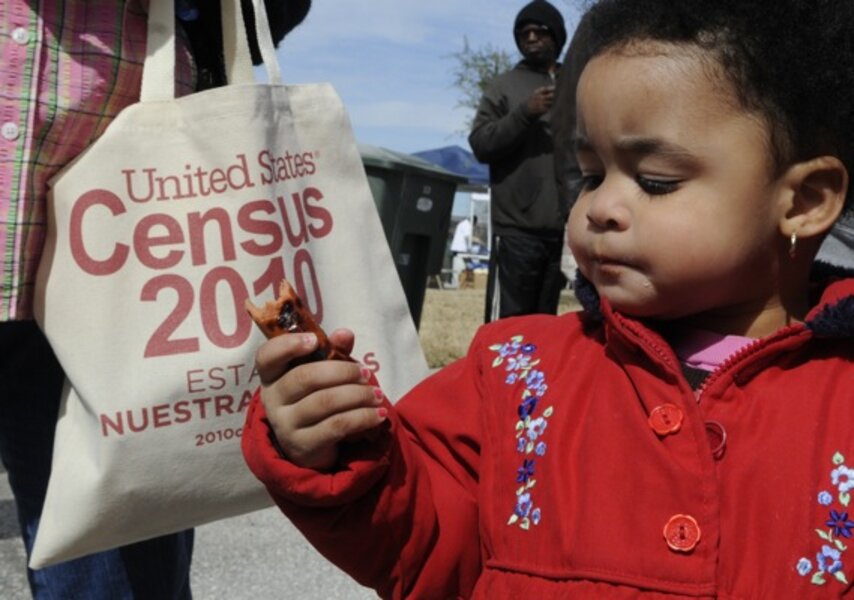How states rank: Federal spending driven by census data
Loading...
| New York
In the weeks ahead, tens of millions of Americans will be asked to provide information for the US census.
For the states and the District of Columbia, the Census Bureau says, more than $400 billion in federal spending is at stake. (For more on the 2010 Census, click here.
So: Which states will benefit the most from an accurate census?
On a per capita basis, the answer is rural areas and places with a large poor population, according to an analysis released Tuesday by the Brookings Institution’s Metropolitan Policy Program.
The following conclusion may be surprising to some: Politics does not appear to have played a large role in which states get more money. For example, the state of Nevada – which has high-ranking Democrat Harry Reid in the Senate – came in last in terms of per capita spending of federal dollars as related to census numbers.
“In general, politics does not enter in. Congress sets the formulas,” says Andrew Reamer, a Brookings fellow who did the analysis. “Most states get their money based on numbers, which is why an accurate census is so important.”
Mr. Reamer looked at the data in terms of metropolitan areas, counties, and states. In terms of metro areas, state capitals dominated in per capita spending – in large part because money flows from Washington to the state capitals for further distribution. Thus, the top five metro areas were all capitals: Albany, N.Y.; Sacramento, Calif.; Baton Rouge, La.; Harrisburg, Pa.; and Austin, Texas.
A look at the states may better illustrate how the census matters. Here’s one part of that analysis: The largest state program that relies on federal census statistics is Medicaid, the program for individuals who are not covered by private health-insurance programs and have low incomes. Medicaid represents about 58 percent of the federal census-driven dollars.
However, it’s not just a large population that matters for Medicaid. Instead, each state determines income-level eligibility, plus what health issues will be covered. What this means is that California, America’s most populous state, ranks 20th in terms of per capita federal spending based on census numbers. Vermont, meanwhile, has a generous Medicaid program, meaning that the rural state ranks second.
But it’s not just Medicaid that matters. In 2008, at least two states – Louisiana and Mississippi – received extra funding as a result of hurricane Katrina, which took place in 2005. These states received a larger share of housing, community, and redevelopment funds, which are normally census-based.
Here are the top 10 states in Reamer’s per capita analysis (although you’ll see that the ranking of states also includes the nation’s capital):
1. The District of Columbia. The District, Reamer says, has a generous Medicaid program to help it treat a population that has a large number of very poor residents. The city gets reimbursed by the federal government for 70 percent of its Medicaid expenditures. That figure is one of the highest in the United States.
2. Vermont. The state also has a generous Medicaid program, as well as children’s healthcare coverage. While the US on average spends 60.9 percent of census-driven federal dollars on healthcare, Vermont spends 67.5 percent.
3. Alaska. The state received $1.8 billion total – with $380 million, or 20 percent, going toward highways. That is three times the national average. “There are few people [in the state], and it takes a lot of expenditures to serve a few people,” Reamer says.
4 and 5. New York and Massachusetts. Both have generous Medicaid programs, and New York has a large poor population.
6. Louisiana. It received a disproportionate share of community and redevelopment funds as part of its post-Katrina recovery.
7. Tennessee. Because it has a large poor population, it received one of the highest percentages of Medicaid reimbursement.
8. Maine. The state has one of the most generous Medicaid programs in terms of eligibility. A Maine resident that is within 206 percent of the federal poverty level is eligible for Medicaid. The national average is 63 percent of the federal poverty level.
9. New Mexico. It has a high number of poor people, so it receives a high Medicaid reimbursement rate.
10. Mississippi. The state has a large poor population and received a high proportion of federal dollars for housing, reflecting Katrina recovery.





